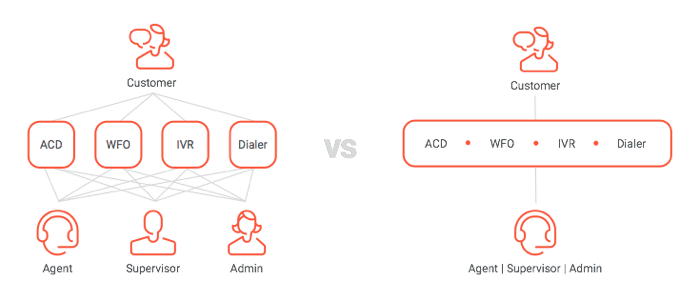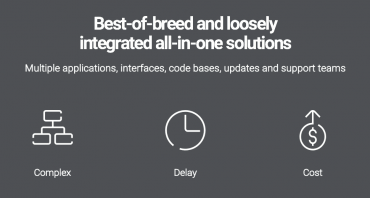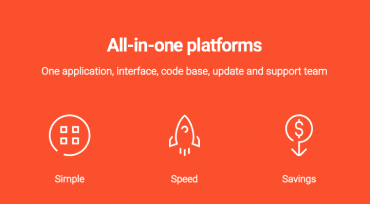According to Merriam-Webster, the term “all-in-one” was first used in 1926 to describe an undergarment that combines a girdle and brassiere in one piece. <blushing> Given support is a key function of the contact centre, it stands to reason all-in-one has been, and continues to be, an important topic in our industry.

All kidding aside, there’s quite a bit of confusion around all in one. Customers want a clear understanding of what it really means, why it matters, whether or not it applies to the cloud, and what capabilities should be included. Lack of clarity leaves buyers feeling confused or even misled after the sale. This is frustrating and, having a long history of developing all-in-one platforms, we’ll answer some common questions to provide clarity and improve the buying experience.
What Does All-in-One Mean?
All-in-one is loosely defined as a solution offered by a single provider that combines two or more capabilities that typically run on separate platforms/machines. Each capability is added via native development or in a more loosely integrated fashion via acquisition or partnership. All-in-one platforms provide a unique approach in that each capability is developed natively on the platform and designed to work together — with other capabilities — as a single application from the start.
All-in-one platform [ awl-in-wuhn-plat-fawrm ]
noun
1. A platform used to build an all-in-one solution comprised of two or more capabilities developed natively to work together as a single application.

What Are the Primary Benefits of All-in-One Platforms?
Best-of-breed solutions fused together, as well as all-in-one solutions with loosely integrated capabilities assembled through acquisition or partnership, create added complexity, unnecessary delay, IT strain and additional costs. Ultimately, this leads to end customers and employees not getting the experience they deserve and expect.
All-in-one platforms, on the other hand, offer an elegant alternative that provides companies relief in the form of a single application that reduces complexity, speeds business and reduces TCO. End customers and employees get a modern experience, even when IT resources and budgets are limited.


Do Cloud Customers Get These Same Benefits?
Absolutely. Prior to the massive market shift to cloud, an elegant all-in-one architecture was the No. 1 reason companies selected our on-premises platform. With the shift to cloud, many thought that all in one would become a less important buying criteria as the added complexity, inefficiency and cost that came with alternative architectures would be absorbed by cloud providers. That proved not to be the case.
Data shows an elegant all-in-one architecture is a top reason customers choose the Genesys Cloud platform. When evaluating solutions, companies quickly realise the added complexity, inefficiency and cost associated with alternative cloud architectures is passed on to them — the end user. Native all-in-one cloud platforms are best suited to deliver on the promises of the cloud: simplicity, speed and economics.
What Capabilities Do All-in-One Platforms Include?
The quick answer is: everything you need to perform a certain job well.
In the contact centre, the job is all about strengthening customer relationships and reinforcing the brand by enabling intuitive, meaningful and memorable conversations across — and between — all channels of communication. This includes capabilities in the following categories: traditional call centre, digital channels, digital sales and service automation, workforce engagement management, reporting and analytics, integrations, and marketplace apps and voice services.
Some companies prefer to have a single all-in-one platform for contact centre and business communications to streamline operations and create tighter collaboration between agents and other employees affecting the customer experience. That’s certainly an option. Alternatively, all-in-one contact centre platforms can integrate easily with popular third-party business communications platforms from Microsoft, Cisco and others.
The following is a representative list of capabilities you can expect all-in-one contact centre and (optionally) business communications platforms to provide.
| Category | Capabilities |
| Traditional call centre | ACD, skills-based routing, advanced routing, IVR, automatic speech recognition (ASR), outbound dialling, callback and supervisor monitoring |
| Digital channels | Chat, email, text/SMS, social and messaging |
| Digital sales and service automation | Voicebots, chatbots and customer journey management |
| Workforce engagement management | Recording, quality management, workforce management, strategic planning, speech and text analytics, and customer surveys |
| Reporting and analytics | Dashboards, standard reports, custom reports, data integration and export |
| Integrations and apps | AI integrations, CRM integrations, WFM integrations, UC integrations, open APIs and an app store |
| Voice services | Internet-based telephony service, with the option to bring your own carrier (BYOC) |
| Business communications (optional) | IP-PBX, speech-enabled auto attendant, softphone, persistent individual and group chat, video conferencing, screen sharing, and voice services (see above) |
What Else Is Important When Evaluating All-in-One Platforms?
There’s a lot to consider; however, the following are my top three.
- Choose your technology provider wisely. Make sure they have a track record of delivering both innovation and stability. Check out their history of innovation, make sure uptime is guaranteed and publicly available, confirm financials are sound and the company isn’t drastically overvalued, and verify the area you’re investing in is a core part of the provider’s business (e.g., where the investment dollars will ultimately go when times are tough).
- Pick an all-in-one platform that delivers a product built for people. This means having seasoned user experience pros on the development team that are empowered to influence product decisions and direction. Even if a platform has the most tightly integrated capabilities built to work together, your teams won’t fully realise the benefits of an all-in-one platform if they aren’t built with the user in mind.
- Verify the all-in-one platform is built for change. This means new capabilities, as well as updates to existing ones, are delivered continuously via microservices to ensure the customer and employee experience is always relevant. Microservices can be delivered as part of the all-in-one application itself, or as a complementary service purpose-built to work with native capabilities.
To keep pace with change, open APIs and an app store are important, as they tap into a broader developer pool to extend the value of the platform. Some companies will choose to build on the platform, others will choose to combine all-in-one capabilities with complementary apps. The point is: Choose an all-in-one platform that’s capable of continuously delivering innovation through provider and other development resources.
Final Thoughts
There’s a lot more we could talk about. However, the information above should give companies most of what they need to make the buying process more pleasant and fruitful if all-in-one is an important consideration. Oh yeah, wait. One more thing: Be sure to see the all-in-one platforms you’re evaluating in action. Gain the perspective of all users, including agents, supervisors and administrators. The platform’s true colors will come shining through.
For a closer look at the platform, check out this 10-minute demo video. Or feel free to make yourself at home and take the tour. Otherwise, please reach out with any additional questions you have.
Here’s to using an all-in-one platform to give customers and employees the experience and support they deserve.
The original article was published here on September 24, 2019.



